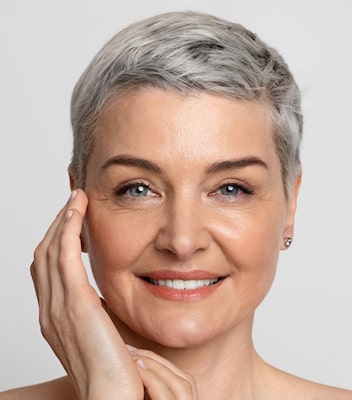
As a person ages, the appearance of the skin can start to look older so many patients turn to a facelift to try and gain a youthful and more rejuvenated appearance. A facelift can reduce the appearance of wrinkles and signs of aging on the face by lifting and tightening the underlying muscles as well as removing excess fat and skin. A facelift remains a popular choice to “turn back the clock.” As recently as 2020, the American Society of Plastic Surgeons reported that more 234,000 patients had a facelift that year. One of the first things patients want to know is how much younger they will look after the surgery. While this is not an easy question to answer (since each patient will heal and gain a rejuvenated look on an individual basis), there is a new approach that is being used to try and assess the extent of the rejuvenated look a person will gain after having a facelift.
 There is some research that suggests the use of artificial intelligence (AI) networks can be utilized to estimate the age of a person after a facelift based on facial photos of the patient.
There is some research that suggests the use of artificial intelligence (AI) networks can be utilized to estimate the age of a person after a facelift based on facial photos of the patient.
According to James P. Bradley, MD, Vice Chairman of Surgery, Zucker School of Medicine at Hofstra/Northwell, “Our study shows that currently available AI algorithms can recognize the success of facelifting, and even put a number on the reduction in years of perceived age.” Bradley is the senior author of the study that was published in 2021 in Plastic & Reconstructive Surgery®.
The study was conducted using a type of AI algorithm that is known as convolutional neural networks. Bradley said, “By training on datasets containing millions of public images, these neural networks can learn to discern facial features with much higher ‘experience’ than a typical person.
The study involved the use of four different, but publicly available, neural networks in order to make objective estimates of the facial age of fifty patients who had a facelift. The estimates made by the AI algorithm used standardized photos that were taken of the patients before their procedure and at least one year after their facelift surgery. The results provided by the AI algorithm were compared to the subjective ratings patients made of their appearance as well as responses to a FACE-Q questionnaire (AKA a standard patient-rated evaluation).
The patients involved in the study were all female and their average age was 58.7 years. In addition, the AI algorithms that were used in the study showed an accuracy of 100% in identifying the age of the patients based on their “before” photos taken prior to a facelift procedure.
The “after” photos showed some different results as the neural networks were able to recognize a reduction in age of 4.3-years after a person had facelift surgery. The recognized reduction of 4.3-years was much lower than the reduction in age of 6.7-years that was identified and rated by the actual patients. When addressing this gap in the recognized amount of age reduction, Bradley noted patients have a tendency to “overestimate how much younger they look after facelift surgery – perhaps reflecting their emotional and financial investment in the procedure.”
When looking at the results of the FACE-Q questionnaire, the patients appeared to be quite happy with the final results of their facelift procedure. The average scores they provided (on a scale of zero to one hundred) included a score of 75 for their facial appearance and a score that was over eighty for their quality of life. In addition, the neural network estimates of the age reduction of the patients were directly correlated to the amount of satisfaction felt by a person. Bradley said, “The younger the AI program perceives a patient’s age, the greater their satisfaction with the results of their facelift.”
The findings from the study suggest that AI can provide both a reliable and objective estimate of the reduction in age that is apparent to others after a facelift surgery. In addition, these age estimates seem to provide an accurate indication of the satisfaction scores reported by patients even if the reduction in years does not completely match the subjective rating provided by the patient.
It should be noted that patients should also ask their doctor of choice to provide “before and after” pictures of actual patients they have treated in order to get a good idea of the type of results they can expect when it comes to reversing the aging process on the face.
In conclusion, Dr. Bradley added, “Together with powerful image analysis tools used in modern plastic surgery, neural networks may play a useful role in counseling patients and demonstrating successful results of facial rejuvenation procedures. We think that AI algorithms could also play a useful role for plastic surgeons in asserting their own results and comparing the outcomes of different techniques.”
- MA